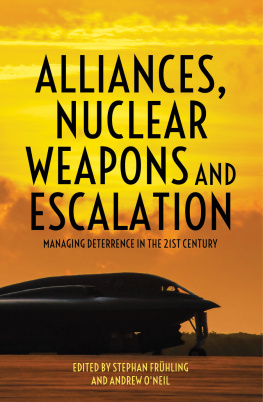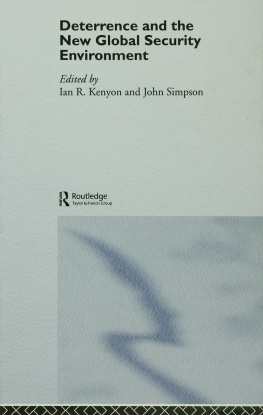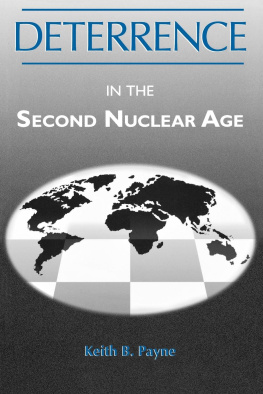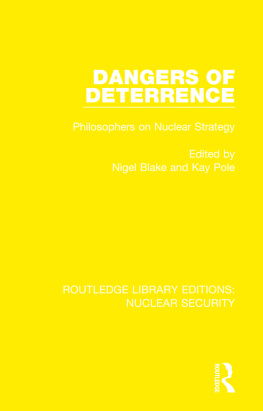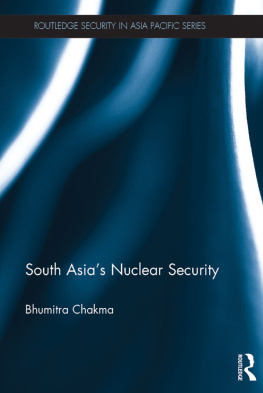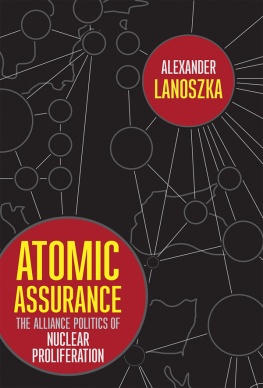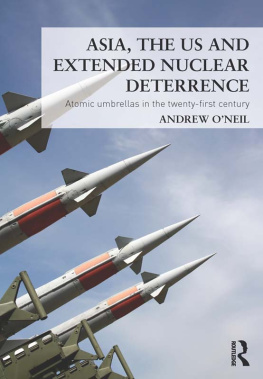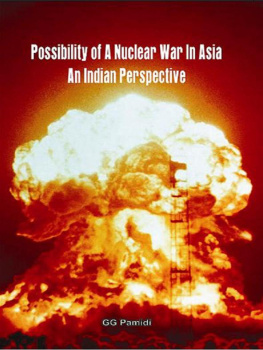Alliances, Nuclear Weapons and Escalation
Managing Deterrence in the 21st Century
Edited by Stephan Frhling and Andrew ONeil

Published by ANU Press
The Australian National University
Acton ACT 2601, Australia
Email: anupress@anu.edu.au
Available to download for free at press.anu.edu.au
ISBN (print): 9781760464905
ISBN (online): 9781760464912
WorldCat (print): 1285533360
WorldCat (online): 1285533216
DOI: 10.22459/ANWE.2021
This title is published under a Creative Commons Attribution-NonCommercial-NoDerivatives 4.0 International (CC BY-NC-ND 4.0).

The full licence terms are available at creativecommons.org/licenses/by-nc-nd/4.0/legalcode
Cover design and layout by ANU Press
Cover photograph: B-2 Spirit operates at Naval Support Facility Diego Garcia. Tech. Sgt. Heather Salazar. The appearance of U.S. Department of Defense (DoD) visual information does not imply or constitute DoD endorsement.
This book is published under the aegis of the Asia-Pacific Security Studies Editorial Board of ANU Press.
This edition 2021 ANU Press
Acknowledgements
No book, and certainly no edited volume, sees the light of day without the significant support of those behind the scenes. We are very grateful to Dr Emily Robertson for her outstanding research assistance and project management skills that were integral in preparing the volume. We thank all contributors for their sustained commitment to the project during what was for many an exceptionally difficult period navigating the impacts of COVID-19. We would also like to thank Dr Greg Raymond and Emily Tinker at ANU Press for their continuing support for the project and the two anonymous reviewers who provided important suggestions on improvements to the manuscript.
Finally, we gratefully acknowledge the generous financial support for this project provided by Australias Department of Defence through its Strategic Policy Grants scheme.
Stephan Frhling
Canberra
Andrew ONeil
Brisbane
Abbreviations
ACM | Alliance Coordination Mechanism |
ADF | Australian Defence Force |
ANZUS | Australia, New Zealand, United States Security Treaty |
APEC | Asia-Pacific Economic Cooperation |
ASAT | anti-satellite |
ASEAN | Association of Southeast Asian Nations |
ASW | anti-submarine warfare |
BMD | ballistic missile defence |
CCP | Chinese Communist Party |
CPGS | conventional prompt global strike |
CPS | conventional prompt-strike |
CSIS | Centre for Strategic and International Studies |
DCA | dual-capable aircraft |
DDA | Deterrence and Defence of the Euro-Atlantic Area |
DDPR | Deterrence and Defence Posture Review |
DSC | Deterrence Strategy Committee |
EDSCG | Extended Deterrence Strategy & Consultative Group |
EDT | emerging and disruptive technologies |
FDO | flexible deterrent options |
ICBM | intercontinental ballistic missile |
ICRC | International Committee of the Red Cross |
INDOPACOM | Indo-Pacific Command |
INF | Intermediate-Range Nuclear Forces |
LDP | Liberal Democratic Party |
MRBM | medium-range ballistic missile |
MSDF | Maritime Self-Defense Forces |
NATO | North Atlantic Treaty Organization |
NDPG | National Defense Program Guidelines |
New START | New Strategic Arms Reduction Treaty |
NFU | no first use |
NPG | Nuclear Planning Group |
NPR | Nuclear Posture Review |
NPT | Treaty on the Non-Proliferation of Nuclear Weapons |
NWS | nuclear weapon states |
OPLAN | operational plan |
PLA | Peoples Liberation Army |
PRC | Peoples Republic of China |
ROK | Republic of Korea |
SACEUR | Supreme Allied Commander Europe |
SDF | Self-Defense Forces |
SLBM | submarine-launched ballistic missiles |
SLCMN | Sea-Launched Cruise Missile Nuclear |
SSA | Space Situational Awareness |
THAAD | Terminal High Altitude Area Defense |
TPNW | Treaty on the Prohibition of Nuclear Weapons |
UK | United Kingdom |
UN | United Nations |
US | United States |
USFK | US Forces Korea |
Alliances, Nuclear Weapons and Escalation
Stephan Frhling and Andrew ONeil
As great power competition once again assumes a central place in international relations, alliances have taken on renewed importance in the security calculations of Australia and other US allies in the Indo-Pacific and Europe. Deterrence of an attack on allies is a core function of US alliances, as are mechanisms through which states seek to manage the risk of escalationthe movement through increasing intensity of conflict up to, in the extreme, global nuclear war. Alliances seek to prevent escalation in the form of an attack on its members through strategies of deterrence and extended deterrence that are themselves predicated on credible threats of escalation. Nuclear weapons are central to deterrence and escalation considerations and form a key component of Americas strategic toolkit to reassure Japan, South Korea and Australia in the Indo-Pacific, as well as North Atlantic Treaty Organization (NATO) allies in the Euro-Atlantic.
However, allies cannot afford to be passive actors in their interactions with Washington. They need to prepare for and seek to manage escalation in a broader geostrategic, technological and political context that shapes the ability of alliances to adapt to a new security environment. While the challenge of great power competition is acute at both ends of Eurasia, adversary threats, geography and the institutional context of US alliances differ. This volume brings together contributors from Europe, North-East Asia, the United States and Australia to better understand these challenges, identify commonalities and differences across regions, and pinpoint ways to collectively manage nuclear deterrence in twenty-first-century alliances. It focuses on nuclear deterrence in the Indo-Pacific and strategic competition between the US and China; the role of non-nuclear US allies in the Indo-Pacific and Europe in supporting US extended nuclear deterrence; political-military challenges in alliance plans for escalation; allied perspectives on the consequences of new non-nuclear capabilities, including cyber and hypersonic weapons, for deterrence and strategic stability; and lessons on how the US and allied nations can better engage their respective publics on questions relating to nuclear deterrence.

